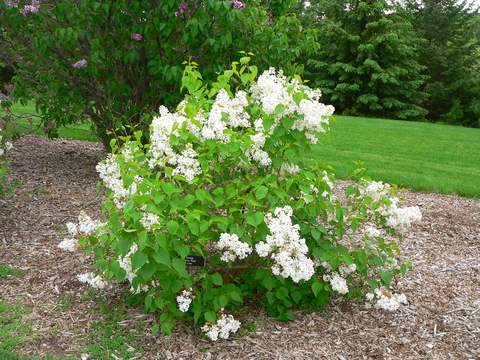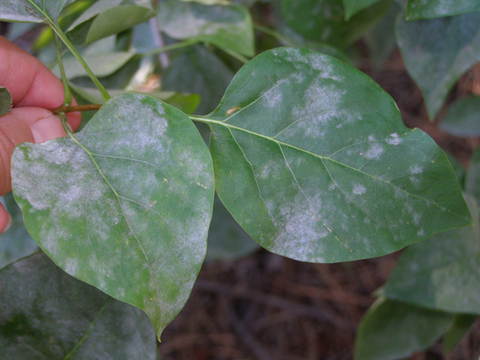Quick facts
- Lilacs may take a few years to bloom after planting.
- Once established, lilacs can live a long time.
- Lilacs need pruning immediately after blooming to promote flowering the next year.
- Lilacs usually produce new growth (suckers) from the root area.
- Planting a variety of lilac species and hybrids can provide continuous fragrance and extend the bloom time into early summer.
Lilacs are a favorite, long-lived, spring-blooming shrub. They are primarily grown for their fragrant flowers ranging from white to pink to deep purple.
Lilacs are native to Eastern Europe and Asia. The genus Syringa comes from the Greek word syrinx meaning pipe or tube and refers to the lilac’s stem which can be hollowed out.
In the landscape, lilacs make excellent hedges, foundation plants, specimen plants, large borders and group plantings. They bloom for 10 to 14 days, depending on the weather, and have a distinctive sweet fragrance.
Lilacs also provide habitat for small birds and pollinating insects.
Growing lilacs
- Hardiness zone: 3 to 7 depending on the species.
- Full sun (6+ hours); less sun reduces flowering and increases powdery mildew.
- Moist, well-drained soil; avoid wet soils with poor drainage.
- Soil pH 7.0 to slightly alkaline. Have your soil tested by the U of M Soil Testing Lab.
- Space new plants based on mature size.
- Planted too close, lilacs will require more pruning and will reduce bloom.
- Proper spacing increases air circulation and reduces powdery mildew.
- Once the lilac is established (2 to 3 years after planting), fertilize every few years with an all-purpose shrub fertilizer.
- Avoid applying lawn fertilizers near or around lilacs as the high nitrogen content will increase leaf production and decrease flower production.
- Water after planting. Make sure the soil drains easily and does not pool.
- Poor drainage can result in stunted growth, fewer flowers and root rot.
- This video (28:44) gives selection, planting and growing information.
Lilac maintenance
Like other spring blooming shrubs, lilacs develop flower buds for the next year after blooming during the current year. Lilacs should be deadheaded immediately after blooming to encourage good bud development and flowering the following spring.
- Deadhead: Use a hand pruner to cut off dead flower heads down to a pair of leaves, or use a hedge trimmer for larger plantings. Shear lightly, taking off only the dead flower heads.
- Renewal pruning: Renewal pruning allows more light throughout an older plant and encourages new stems to grow and flower. Newly planted lilacs usually do not need pruning for 2 to 3 years and it will take 1 or 2 years before a lilac blooms. Years later, lilac stems can grow very large and tree-like and they will tend to shade out new growth at the plant base.
- Use a lopper or hand saw to remove a third of the thickest stems at the base.
- Do this every year until all large stems are removed.
- Rejuvenation pruning is a technique for smaller, densely-branched lilacs like Korean or Meyer lilacs (Syringa meyeri) that have become overgrown.
- In late winter, use a saw or hedge trimmer to cut the entire plant to the ground.
- New growth will grow from the root area in spring.
- The plant may not bloom or sparsely bloom for 1 or 2 years.
- Powdery mildew is common and cosmetic only; choose disease-resistant cultivars.
- Lilac borer is the larvae of the clearwing wasp.
- Bacterial blight is more common in cool, wet weather.
Causes for a lack of flowers:
- Plant is not yet well-established. After planting, a lilac’s energy reserves will be used for developing a strong root system rather than flowers or leaves. Some blooming may begin in years 2 and 3. Be patient and continue to care for your lilac.
- Plants are not receiving enough sunlight. Make sure your lilac has 6 or more hours of full sun per day. If the lilac has become shaded by another plant over time, consider pruning the other plant.
- Too much nitrogen fertilizer is being applied, causing the plant to put energy into growing leaves, not flowers. Don't apply lawn fertilizers (high in nitrogen) around the base of lilacs. Plant lilacs in garden beds, not lawns.
- Pruned at the wrong time of year and cut off flower buds. Lilacs set flower buds for the next year right after blooming is finished, so prune immediately after flowering.
- For more about lilac issues and solutions see What’s wrong with my plant?
Species and cultivated varieties of lilacs for Minnesota
The following section is not a complete list of cultivars available commercially. For a wider selection:
- Visit your local garden center. Have a list of plant features you want in a lilac, especially the size of your planting space.
- Use our plant selection program. It is free and takes just a few minutes to set up and confirm your user account. Instructions can be found at Plant Elements of Design.
- Read Lilacs for Cold Climates by Dr. Laura Jull, associate professor in horticulture, University of Wisconsin Extension.
The following lilac species and cultivated varieties are organized by bloom time (early to late). Plant sizes are listed height x width. Hardy in zones 3-7 unless otherwise indicated.
Syringa x hyacinthiflora, Early flowering lilac, Hyacinth lilac: 7-12 ft x 8-10 ft. Good for foundation plants. Disease resistant. Cultivars: ‘Excel’, ‘Maiden’s Blush’, ‘Pocahontas’
S. oblata, Early lilac, Broadleaf lilac: 8-12 ft x 8-10 ft. Compact form. Disease resistant. Cultivars: ‘Betsy Ross’, subsp. dilatata Korean early lilac, ‘Cheyenne’
S. x chinensis, Chinese lilac: Zone 4a. 7. 8-12 ft x 8-12 ft. Prolific blooms, dense leaves and flowers down to the ground; good for a large screen. Diseases: powdery mildew, bacterial blight. Cultivars: ‘Saugeana’, ‘Lilac Sunday’
S. x laciniata, Cutleaf lilac, Cutleaf Persian lilac: Zone 4b. 5-6 ft x 5-8 ft. Rounded, open form, little pruning needed. Disease resistant.
S. meyeri ‘Palibin’, Meyer lilac, Palibin lilac, dwarf Korean lilac: Zone 4a. 4-6 ft x 4-6 ft. Forms a good, low screen. Disease resistant. Cultivars: ‘Palibin’
S. x persica, Persan lilac: 4-8 ft x 5-8 ft. Sterile, no seed capsules produced after blooming. Disease: powdery mildew, bacterial blight.
S. pubescens ssp. patula, Manchurian lilac: 5-7 ft x 4-6 ft. Good for foundation plants. Cultivars: ‘Miss Kim’, ‘Klmone' Miss SusieTM
S. vulgaris, common lilac, French lilac: 8-15 ft x 6-12 ft. Good for hedges, living fences, tall borders, wildlife. Diseases: powdery mildew, bacterial blight; some cultivars are resistant. Cultivars: ‘Sensation’, ‘Mme. Lemoine’, ‘Wonderblue’, ‘Ludwig Spaeth’, 'Beauty of Moscow’, ‘Primrose’, ‘Alba’, ‘President Grevy’, ‘Edith Cavelle’, ‘Katherine Havemeyer’, ‘Charles Joly’, 'Mrs. W.E. Marshall’, ‘Mme F. Morel’, ‘Montaigne’.
S. baibelle PP12,294, Tinkerbelle® lilac: 4-6 ft x 4-5 ft. Disease resistant. Developed by Neal Holland, Sheyenne Gardens, ND. Other plants in the Fairytale® series introduced by Bailey Nurseries (MN): S. Baillina, ‘Thumbelina®, S. Bailming, Prince Charming®, S. Bailsugar, Sugar Plum Fairy®, Baildust, Fairy Dust®.
S. x prestoniae, Preston lilac: Late blooming, more red in flower color. Cultivars: ‘Miss Canada’, ‘Minuet’, ‘Hiawatha’, ‘Donald Wyman’
Images of some of the lilac varieties listed above
(click on an image to enlarge)
S. x 'SMSJBP7' PP26,594, Bloomerang® Dark Purple Lilac: 4-5 ft x 4-5 ft. A key feature of this lilac is that it blooms both in spring and late summer. Disease resistant.
Reviewed in 2019




